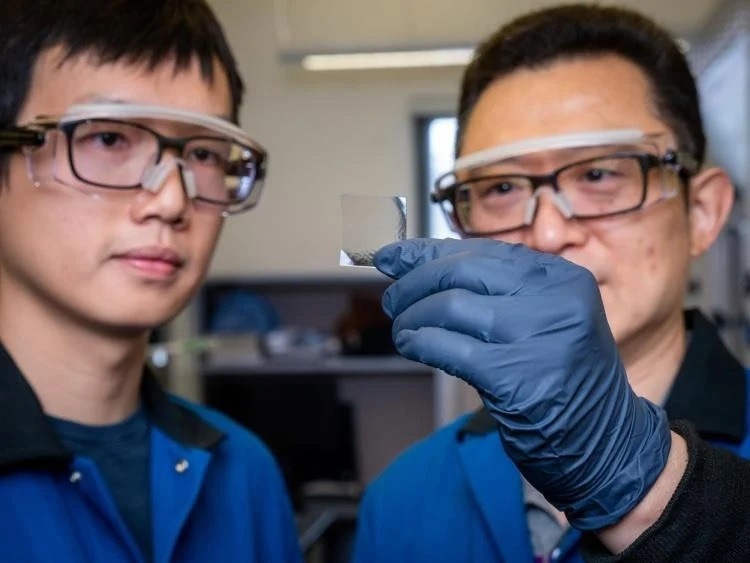Reviewed by Alex SmithSep 27 2022
In the not-too-distant future, the plastics in our cars, electronics, and satellites might exist in their second, 25th, or 250th lives.
 Chemistry chair Wei Zhang (right) and Graduate Research Assistant Zepeng Lei study plastic materials in the Zhang Lab. Image Credit: Patrick Campbell/CU Boulder
Chemistry chair Wei Zhang (right) and Graduate Research Assistant Zepeng Lei study plastic materials in the Zhang Lab. Image Credit: Patrick Campbell/CU Boulder
A new study from CU Boulder explains how a class of durable plastics extensively employed in the microelectronics and aerospace industries can be broken down chemically into their most fundamental building blocks and then created into the same material once again. Nature Chemistry published this study.
It is a huge step in the development of fully recyclable and repairable network polymers, which is a particularly difficult material to recycle, as it is made to retain their integrity and shape in adverse heat and other extreme conditions. How this type of plastic can be continuously broken down and recycled, with no compromise on its required physical properties, was documented in this study.
We are thinking outside the box, about different ways of breaking chemical bonds. Our chemical methods can help create new technologies and new materials, as well as be utilized to help solve the existing plastic materials crisis.
Wei Zhang, Study Lead Author and Chair, Department of Chemistry, University of Colorado Boulder
Their finding also proposes that reconsidering the chemical structures of other plastic materials can result in identical findings on how to completely break down and recreate their chemical bonds, which could enable the circular production of more plastic materials in everyday life.
During the mid-20th century, plastics were universally embraced in most industries and in part of daily life as they are very practical, convenient, and economical. But after half a century has passed, with subsequent multi-folds of demand and production, plastics pose a key threat to the planet’s and people’s health.
Huge quantities of oil and the burning of fossil fuels are required for the production of plastics. Disposable plastics form hundreds of millions of tons of waste annually, ending up in oceans, landfills, and even in human bodies in the form of microplastics.
Therefore, recycling is essential in decreasing fossil fuel emissions and plastic pollution now.
Traditional recycling methods break down polymers into powders mechanically and burn or dissolve them using bacterial enzymes. The objective is to reach for smaller pieces that can be employed for other things. For instance, shoes crafted from recycled rubber tires or clothing stitched from recycled plastic water bottles. Even if it is no more the same material, it does not reach a landfill or the ocean ultimately either.
But what if a new item could be rebuilt using the same material? What if recycling did not only provide additional life to plastics but also a repeat experience?
Zhang and his coworkers have succeeded in exactly the same: They upturned a chemical approach and found that they can both break and create new chemical bonds in a specifically high-performance polymer.
This chemistry can also be dynamic, can be reversible, and that bond can be reformed. We are thinking about a different way to form the same backbone, just from different starting points.
Wei Zhang, Study Lead Author and Chair, Department of Chemistry, University of Colorado Boulder
Researchers conducted this research by breaking the polymer (“poly” meaning “many”) into singular monomers, or its molecules—which is a concept of dynamic or reversible chemistry. This latest method’s novelty lies in the fact that it has not only formed a new class of polymer material—which are easy to build, break apart, and rebuild again like Lego—but it can also be applied to the current, particularly hard-to-recycle polymers.
Such novel chemical methods are also all set for commercialization and can plug and play with existing industrial production.
It can really benefit future design and development of plastics to not only create new polymers, but it’s also very important to know how to convert, upcycle and recycle older polymers. By using our new approach, we can prepare many new materials—some of which could have similar properties to the plastics in our daily life.
Wei Zhang, Study Lead Author and Chair, Department of Chemistry, University of Colorado Boulder
Zhang said that this progress in plastics’ closed-loop recycling is inspired by the natural world since animals, plants, and human beings are now a part of a planetary-level, circular system of recycling in a similar manner.
Zhang concludes, “Why can’t we make our materials the same way?”
Zepeng Lei, Hongxuan Chen, Yicheng Rong, and Yiming Hu, Department of Chemistry, University of Colorado Boulder; Chaoqian Luo and Kai Yu, Department of Mechanical Engineering, University of Colorado Denver; Yinghua Jin, RockyTech, Ltd. Boulder, Colorado; and Rong Long, Department of Mechanical Engineering, University of Colorado Boulder are the additional authors of this study.
Journal Reference:
Lei, Z., et al. (2022) Recyclable and malleable thermosets enabled by activating dormant dynamic linkages. Nature Chemistry. doi.org/10.1038/s41557-022-01046-4.